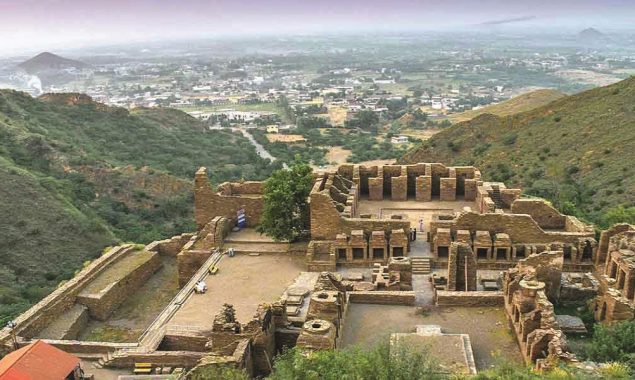Synopsis
Documentary film on Buddhist heritage of Pakistan reveals complex cultural influences

ISLAMABAD: The documentary film ‘Gandhara: The Buddhist Heritage of Pakistan’ has showcased the Gandhara civilization that flourished between the 1st century CE to 7th century CE in different parts of the country.
The documentary sheds light on the historical roots of Gandhara civilization and captures the entire landscape of historical sites with the help of drone camera.
It shows the lush green mountainous regions of the country and visible intact structures of Buddhist historical heritage sites with panoramic scenes of high altitude mountain peaks of Pakistan.
The architectural and artistic stonework of Gandhara such as statues, stupas, monasteries, temples, houses, and the zigzag tracks leading to the historical sites of the remains make for an eye-catching view.
Gandhara, literally mean the land of fragrance, is the name of the region included Peshawar valley, Buner, Bajaur, and hills of Swat valley — the north-western areas of present-day Pakistan. It was this region which gave birth to the glorious and ancient Gandhara civilization.
Subsequently, the civilization had started spreading in all directions including Afghanistan and Potohar plateau in Punjab and Sindh.
The Gandhara civilization represents human development, knowledge, religion, art, and history. The modern city of Taxila was a famous centre of learning for art, architecture, medicine, and religion.
Similarly, according to archaeologists, the city was home to one of the world’s oldest recognized universities as thousands of students used to come here for education from other parts of the world to study philosophy, politics, music, dance, mathematics, commerce, law, art of hunting, archery, elephant lore, and warfare, etc.
The film was jointly produced by the High Commission of Pakistan in Sri Lanka and Siddhivinayak Cine Arts (Private) Limited in collaboration with the Ministry of Buddha Sasana, Religious and Cultural Affairs of Sri Lanka.
The documentary also focuses on rich historical collection of Buddhist remains discovered from different parts of the country. The artistic work of stone-crafting, relics, utensils, and other artefacts take the viewers on a centuries-old long visual journey to recapture the lifestyle of the civilization from the past. The civilization has left an indelible mark on the historical landscape of world history.
One of the tooth relics of Buddha, discovered from the Gandhara region, has been preserved in Taxila Museum. It is the region where the Gandhara Buddhist civilization reached its pinnacle of glory from 1st century AD to the 7th century AD.
The first anthropomorphic statue of Buddha was created in the region now called Pakistan. One of the world’s oldest Buddhist University, Thakshashila (Taxila in Pakistan) is home to some of the most sacred Buddhist artefacts found during archaeological excavations.
The remains of what is said to be the world’s largest Buddhist monastery exist in Takht-e-Bahi Mardan — it was a complex of buildings consisting of assembly halls, dining areas, and a courtyard and double-storied Buddhist living quarters. It also contained a portion of a temple with a number of stupas, a courtyard, and living cells.
The idea was conceived in order to present this heritage to the Buddhist world in general and Sri Lanka in particular. The documentary will open up new avenues in religious tourism as well as strengthening cultural and people-to-people ties between the brotherly countries of Sri Lanka and Pakistan.
The government of Pakistan, local and foreign technicians including director Mateen Saherai and production controller Sajjad Mohammad (Gateway to Production, England) from England have contributed to the documentary.
The documentary is based on a screenplay that explores the historical ruins and artefacts captured in a realistic way while also exploring background historical information.
Ven Agrahera Kassapa Thero is the senior adviser to the entire project. The concept and script has been prepared by the project consultant director, Vidyajothi Prof Nimal Silva.
The sound and movie editing is done by local Sri Lankan artists.
According to a press release received by APP from the High Commission of Pakistan, Colombo, Sri Lanka, Ms Kaushalya Wickramasinghe, the Chairperson of Siddhivinayak Cine Arts (Private) Limited said that the film was expected to be screened in local cinemas as well as on local TV channels and abroad in collaboration with international organizations.
The Acting High Commissioner of Pakistan, Mr Tanvir Ahmad Bhatti said that “Gandhara” was conceptualized with the aim to bring people of Sri Lanka and Pakistan closer through their shared history and heritage.
Director Taxila Institute of Asian Civilizations, Quaid-i-Azam University, Dr Ghani-ur-Rahman told APP, “The Gandhara Civilization, particularly the Buddhist statue has been influenced by the Greek Civilization as it has followed the face of Greek’s god Apollo.”
He said it was claimed that the Greek-turned Buddhists have introduced the sculpture-making arts and the statue of Gautama Buddha in Buddhism. This influence was more visible due to the fact that the Buddhist sculptors and the artists have learnt a great deal of new techniques and skills from the Greeks, he added.—APP
Read More News On
Catch all the Pakistan News, Breaking News Event and Latest News Updates on The BOL News
Download The BOL News App to get the Daily News Update & Follow us on Google News.




